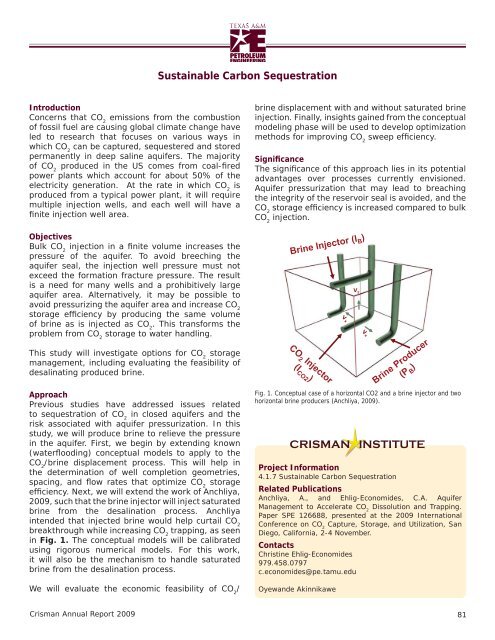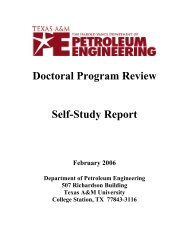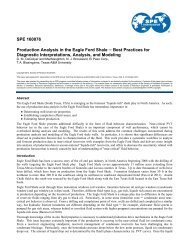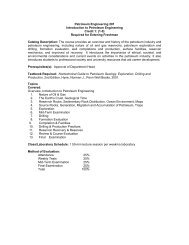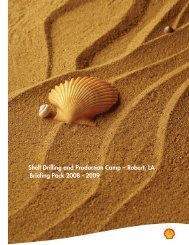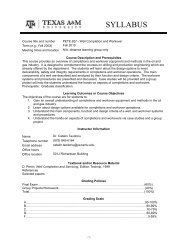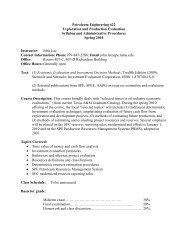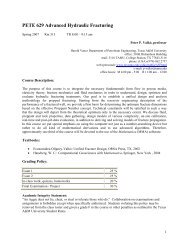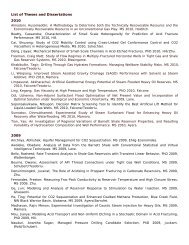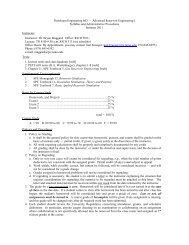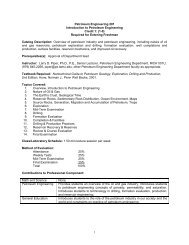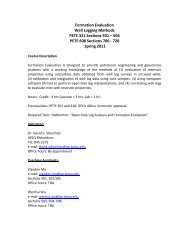Crisman Annual Report 2009 - Harold Vance Department of ...
Crisman Annual Report 2009 - Harold Vance Department of ...
Crisman Annual Report 2009 - Harold Vance Department of ...
Create successful ePaper yourself
Turn your PDF publications into a flip-book with our unique Google optimized e-Paper software.
Sustainable Carbon Sequestration<br />
Introduction<br />
Concerns that CO 2<br />
emissions from the combustion<br />
<strong>of</strong> fossil fuel are causing global climate change have<br />
led to research that focuses on various ways in<br />
which CO 2<br />
can be captured, sequestered and stored<br />
permanently in deep saline aquifers. The majority<br />
<strong>of</strong> CO 2<br />
produced in the US comes from coal-fired<br />
power plants which account for about 50% <strong>of</strong> the<br />
electricity generation. At the rate in which CO 2<br />
is<br />
produced from a typical power plant, it will require<br />
multiple injection wells, and each well will have a<br />
finite injection well area.<br />
Objectives<br />
Bulk CO 2<br />
injection in a finite volume increases the<br />
pressure <strong>of</strong> the aquifer. To avoid breeching the<br />
aquifer seal, the injection well pressure must not<br />
exceed the formation fracture pressure. The result<br />
is a need for many wells and a prohibitively large<br />
aquifer area. Alternatively, it may be possible to<br />
avoid pressurizing the aquifer area and increase CO 2<br />
storage efficiency by producing the same volume<br />
<strong>of</strong> brine as is injected as CO 2<br />
. This transforms the<br />
problem from CO 2<br />
storage to water handling.<br />
brine displacement with and without saturated brine<br />
injection. Finally, insights gained from the conceptual<br />
modeling phase will be used to develop optimization<br />
methods for improving CO 2<br />
sweep efficiency.<br />
Significance<br />
The significance <strong>of</strong> this approach lies in its potential<br />
advantages over processes currently envisioned.<br />
Aquifer pressurization that may lead to breaching<br />
the integrity <strong>of</strong> the reservoir seal is avoided, and the<br />
CO 2<br />
storage efficiency is increased compared to bulk<br />
CO 2<br />
injection.<br />
V z<br />
This study will investigate options for CO 2<br />
storage<br />
management, including evaluating the feasibility <strong>of</strong><br />
desalinating produced brine.<br />
Approach<br />
Previous studies have addressed issues related<br />
to sequestration <strong>of</strong> CO 2<br />
in closed aquifers and the<br />
risk associated with aquifer pressurization. In this<br />
study, we will produce brine to relieve the pressure<br />
in the aquifer. First, we begin by extending known<br />
(waterflooding) conceptual models to apply to the<br />
CO 2<br />
/brine displacement process. This will help in<br />
the determination <strong>of</strong> well completion geometries,<br />
spacing, and flow rates that optimize CO 2<br />
storage<br />
efficiency. Next, we will extend the work <strong>of</strong> Anchliya,<br />
<strong>2009</strong>, such that the brine injector will inject saturated<br />
brine from the desalination process. Anchliya<br />
intended that injected brine would help curtail CO 2<br />
breakthrough while increasing CO 2<br />
trapping, as seen<br />
in Fig. 1. The conceptual models will be calibrated<br />
using rigorous numerical models. For this work,<br />
it will also be the mechanism to handle saturated<br />
brine from the desalination process.<br />
We will evaluate the economic feasibility <strong>of</strong> CO 2<br />
/<br />
Fig. 1. Conceptual case <strong>of</strong> a horizontal CO2 and a brine injector and two<br />
horizontal brine producers (Anchliya, <strong>2009</strong>).<br />
CRISMAN INSTITUTE<br />
Project Information<br />
4.1.7 Sustainable Carbon Sequestration<br />
Related Publications<br />
Anchliya, A., and Ehlig-Economides, C.A. Aquifer<br />
Management to Accelerate CO 2<br />
Dissolution and Trapping.<br />
Paper SPE 126688, presented at the <strong>2009</strong> International<br />
Conference on CO 2<br />
Capture, Storage, and Utilization, San<br />
Diego, California, 2-4 November.<br />
Contacts<br />
Christine Ehlig-Economides<br />
979.458.0797<br />
c.economides@pe.tamu.edu<br />
Oyewande Akinnikawe<br />
<strong>Crisman</strong> <strong>Annual</strong> <strong>Report</strong> <strong>2009</strong><br />
81


